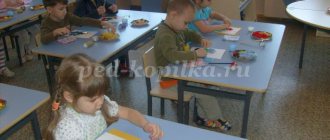The middle line of a triangle is a outline of a lesson in geometry (8th grade) on the topic
Methodological development of a mathematics lesson in 8th grade.
The topic of the lesson is “The midline of a triangle.”
Lesson type: lesson on learning new knowledge
Lesson objectives:
Educational:
- Introduce the concept of the midline of a triangle; prove the property of the midline of a triangle, as well as the theorem on the intersection of the medians of a triangle; consider the properties of the median and midline of a triangle in relation to its area; teach how to use them when solving problems.
Educational:
- To develop interest in geometry, logical thinking, and intuition of students; develop the ability to clearly and clearly express your thoughts;
improve graphic culture.
- To develop the creative and mental activity of students, their intellectual qualities: the ability for research, synthesis and analysis.
Educational:
- Motivate children to self-education.
- Cultivate interest in geometry, broaden students’ horizons
- Instill accuracy in the design of geometric problems and a culture of oral speech.
Equipment, visibility, electronic applications for the lesson:
Computer. Multimedia projector. Document camera.
Microsoft PowerPoint presentation.
Lesson structure.
| Kind of activity. | Slide no. | min. |
| 1. Setting the goal of the lesson. Epigraph for the lesson. | 1-3 | 2 |
| 2. Checking homework | 2 | |
| 3. Repetition of the studied material. Signs of similarity of triangles. | 4-6 | 3 |
| 4. The concept of the midline of a triangle and its properties. Mathematical dictation | 7-9 10-14 | 12 |
| 5. Physical education minute. | 1 | |
| 6. Property of medians of a triangle. Consequences. | 15-17 18-21 | 15 |
| 7. Consolidation of new material. Problem solving. | 22-23 | 8 |
| 8. Summing up. | 24 | 2 |
| 9. Homework. | 25 | 1 |
During the classes.
1. Introductory speech by the teacher.
The epigraph for today's lesson is taken from the words of a French writer of the 19th century. Anatole France once remarked: “You can only learn through fun... To digest knowledge, you need to absorb it with appetite” (side number 2).
Let's follow the writer's advice in today's lesson: be active, attentive, and eagerly absorb knowledge that will be useful to you in later life.
Many famous thinkers and writers of the past have addressed the topics of the remarkable points and lines of a triangle. Today we will also do this interesting research.
The topic of our lesson is “The midline of a triangle.” Let's formulate what goals we must achieve: (students formulate goals independently, slide No. 3)
- Define the midline of a triangle.
- Prove the theorem about the midline of a triangle.
- Prove the theorem about the intersection of the medians of a triangle.
2. Checking homework.
Using a document camera, the solution to homework (No. 568 b) from the student’s notebook is projected onto the screen. The student comments on the solution.
3. Oral work. Repetition of learned material.
Goal: to systematize basic knowledge on the topic “Similarity of triangles”; develop logical thinking; develop the ability to clearly and clearly express your thoughts.
To successfully complete the goals of today's lesson, we will have to refer more than once to signs of similarity of triangles. What signs of triangle similarity do you know? Students formulate signs of similarity between triangles (slides 4-6).
4. The concept of the midline of a triangle and its properties.
Objectives: formulate the definition of the midline of a triangle and prove its property; develop the ability to compare and analyze.
— What do the triangles shown in the picture have in common? (slide No. 7)
Students independently define the midline of a triangle (slide No. 8).
— How many midlines can be built in a triangle?
-The midline of the triangle is the remarkable line of the triangle. What makes her so special? Let's formulate and prove the property of the midline of a triangle (slide No. 9).
Students prove the theorem on their own (the task was given to strong students in advance). In order to consolidate the concept and properties of the middle line of a triangle, a mathematical dictation is carried out (solving problems using ready-made drawings; slide No. 10-14). Students receive cards and complete a mathematical dictation.
Mathematical dictation
| Option 1 | Option 2 |
| 1) The two sides of the triangle are connected by a segment not parallel to the third side. Is this segment the midline of this triangle? | 1) Points A and B are the midpoints of two sides of the triangle. What is the name of segment AB? |
| 2) In ∆ABC side AB=7 cm. What is the average line of the triangle parallel to this side? | 2) The midline of triangle ABD, parallel to side ВD, is 4 cm. What is the length of side ВD? |
| 3) Given: MK=3, KN=4, MN=5. Find the perimeter of triangle ABC. | 3) Given: AB=3m, BC=5m, AC=4m. Find the perimeter of triangle MNK. |
| 4) The ends of the segment AB lie on the sides of the triangle, and its length is equal to half the third side. Is it necessary: AB is the midline of this triangle? | 4) The ends of the segment MN lie on the sides of the triangle. The segment MN is parallel to the third side and equal to its quarter. Is it necessary: MN is the midline of this triangle? |
| 5) The perimeter of the triangle is 5.9 cm. Find the perimeter of the triangle cut off by one of its midlines. | 5) The perimeter of the triangle is 7.3 cm. Find the perimeter of the triangle cut off by one of its midlines. |
5. Physical education minute
6. Property of medians of a triangle
Goal: develop logical thinking; ability for research, synthesis and analysis.
Remember what is called the median of a triangle? (slide No. 15) Indicate the picture that shows the median.
Property of the medians of a triangle: the medians of a triangle intersect at one point, which divides each median in a ratio of 2:1, counting from the vertex (slide No. 16).
Students prove the theorem on their own (the task was given to strong students in advance).
-The median is also considered a remarkable line of a triangle. Why do you think? Remember which triangles are called equal-sized (slide 17)? Let's explore the following assumptions. The median is drawn in the triangle. How will the area change? (slide number 18)
| Statement: The median of a triangle divides it into two equal triangles. |
-In a parallelogram whose area is S, diagonals are drawn. What are the areas of the resulting triangles (slide No. 19)?
Corollary 1: The diagonals of a parallelogram divide it into four equal triangles.
— There are three medians in a triangle. Are they equal in size (slide number 20)?
Corollary 2: The medians of a triangle divide it into six equal triangles.
— The middle lines are drawn in the triangle. What is the area of triangle BMN (slide number 21)?
Corollary 3: the midline of the triangle cuts off from the given triangle the area of which is equal to ¼ of the area of the original triangle.
7. Consolidation of new material. Problem solving
Goal: to teach students to apply the knowledge acquired in class when solving problems; develop logical thinking; instill accuracy in the design of geometric tasks; improve graphic culture.
Task 1. The medians BK and EM, the triangle ALL, intersect at point O. Find SMOK:SCMK (slide No. 22).
Task 2. Solve the problem orally using the finished drawing (slide number 23).
AA1, BB1, CC1 are the medians of the triangle. Prove:
|
8. Summing up
Reflection.
- The segment connecting the midpoints of two sides of a triangle is called the midline of the triangle.
- The midline of a triangle is parallel to one of its sides and equal to half of that side.
- The medians of a triangle intersect at one point, which divides each median in a ratio of 2:1, counting from the vertex.
- The midline of the triangle cuts off from the given triangle the area of which is equal to ¼ of the area of the original one.
- The three middle lines of the triangle divide it into 4 equal-sized triangles, the area of each of them is equal to ¼ of the area of the original one.
Lesson grades.
9. Homework
P. 62, questions 8, 9 (p. 160). Problems No. 616, 571.
Literature
- Geometry: Textbook. for 7-9 grades. general education institutions. / L.S. Atanasyan, V.F. Butuzov, S.B. Kadomtsev et al. – 5th ed. – M.: Education, 1995. – 335 p.: ill. – ISBN 5-09-006554-3
- Lysenko F. F. Mathematics. Preparation for the Unified State Exam. – Rostov-on-Don: “Legion M”, 2012.
- Altynov P.I. Geometry. Tests. 7-9 grades
- Gilyarova M. G. Lesson developments in geometry: 8th grade. Volgograd: “Teacher - AST”, 2003.
- Websites:
Internet state teachers in the Infotech-Mathematics section. https://www.intergu.ru/infoteka/
https://school-collection.edu.ru/
Eye exercises: comp-doctor.ru/eye/eye_upr.php
Shamotina L.V.
GBOU secondary school No. 443
Frunze district
St. Petersburg
Outline of a geometry lesson in 8th grade on the topic
"The middle line of the triangle."
The first lesson in the topic “Applying similarity to proving theorems and solving problems.”
Textbook L.S. Atanasyan “Geometry 7-9”
The purpose of the lesson:
familiarizing students with the concept of the midline of a triangle; developing the ability to apply the property of the midline of a triangle to problem solving.
Learning objectives aimed at achieving:
Personal development:
- continue to develop the ability to clearly, accurately and competently express your thoughts in oral and written speech,
- develop creative thinking, initiative, resourcefulness, and activity in solving mathematical problems.
Meta-subject development:
- broaden your horizons, instill the ability to work together (a sense of camaraderie and responsibility for the results of your work);
- continue to develop the ability to understand and use mathematical visual aids.
Subject development:
- to form a theoretical and practical understanding of the midline of a triangle and its properties;
- develop the ability to apply learned concepts to solve practical problems.
Lesson type: lesson in acquiring new knowledge, skills and abilities.
Forms of student work:
- individual;
- frontal;
- work in pairs.
Necessary equipment:
- Projector and screen.
- Presentation “Midline of a Triangle.”
Lesson structure and flow:
- Organizing time. (Slide No. 1). Lesson topic message. Getting students in the mood for work.
- Oral exercises:
Solve problems:
- (slide No. 2): The diagonals of the quadrilateral ABCD intersect at point O, and AO:OS = VO:OD. Prove that ABCD is a trapezoid.
(Document: Consider triangles AOB and DOS. In them: AO:OS = VO:OD - according to the conditions of the problem, angle AOB is equal to angle DOS - both vertical. This means that triangle AOB is similar to triangle DOS in two proportional sides and the angle between them In similar triangles, the corresponding angles are equal, which means that angle ABO is equal to angle VDS, and they lie crosswise at straight lines AB and DS and secant VD. This means that segment AB is parallel to segment DS.
A quadrilateral in which two sides are parallel and the other two are not is a trapezoid. ABCD - trapezoid).
(Slide No. 3): Point M is the midpoint of side AB, and point N is the midpoint of side BC of triangle ABC. Prove that the segment M N is parallel to side AC. (Document: Consider triangles ABC and BMN.
In them: angle B is common, BM:AB = BN:BC = 1:2. This means that triangle ABC is similar to triangle BMN in terms of two proportional sides and the angle between them. In similar triangles, the corresponding angles are equal, i.e. angle BMN is equal to angle BAC, and they are corresponding for straight lines MN and AC and secant AB, which means that segment MN is parallel to segment AC.)
- Learning new material:
- (slide number 4).
The teacher formulates the definition of the midline of a triangle. Students make appropriate notes in their notebooks.
Question to the class: Guys, what do you think is the property of the middle line of a triangle?
Possible student answers:
- splits triangle ABC into two similar triangles;
-the midline is parallel to the opposite side.
2. The teacher invites students in pairs to discuss the proof of parallelism
the midline of the triangle to the opposite side. At this time, the teacher provides advisory assistance.
Teacher: Guys, what do you think is the length of the middle line of the triangle? Perhaps one of the guys will guess that the middle line of the triangle is equal to half the opposite side.
The teacher formulates the definition of the theorem about the midline of a triangle. (slide No. 5) Students answer the questions: what is given in the theorem? and what needs to be proven? They make a drawing and make the corresponding notes.
The teacher invites students in pairs to prove that the middle line of the triangle is equal to half the opposite side, providing advisory assistance at this time.
(Document: Consider triangles ABC and BMN. In them: angle B is common, BM:AB = BN:BC = 1:2. This means that triangle ABC is similar to triangle BMN in two proportional sides and the angle between them. In similar triangles the corresponding angles are equal, i.e. angle BMN is equal to angle BAC, and they are corresponding for straight lines MN and AC and secant AB, which means that segment MN is parallel to segment AC.
AC: MN = MV:AB = 1:2, i.e. MN = ½AC)
- Oral solution of problems to consolidate the concept of “middle line of a triangle”:
a) (slide 6) In triangle ABC, points E and F are taken on sides AB and BC, respectively, so that AE = EB = 3 cm, BF = FC-4 cm. Will segment EF be the midline of triangle ABC? (yes)
b) (slide 7) In the triangle MNK, points C and D are taken on sides MN and MK, respectively, so that MC = CN = 3 cm, MD = 5 cm, DK = 4 cm. Is segment CD the midline of triangle MNK? (no )
c) (slide 8 KL – the middle line of the triangle DFE. DF=10 cm, FE=12 cm. What are the lengths of the segments DK, KF, FL, LE? (DK=5 cm, KF=5 cm, FL=LE=6 cm) .
d) (slide 9) MK and RK – the middle line of triangle ABC. Is segment MR the midline of this triangle? (yes, because AM = MV and BP = RS)
e) (slide 10) DE – the middle line of triangle ABC. a) Determine the length of side AB if DE = 4 cm. b) DS = 3 cm, DE = 5 cm, CE = 6 cm. Determine the lengths of the sides of triangle ABC. (AB = 10 cm, CB = 6 cm, AC = 12 cm)
f) (slide 11) The sides of the triangle are 4 m, 6 m, 8 m. What are the lengths of the middle lines of this triangle? (MR=3cm, MK=4 cm, KR=2 cm)
g) (slide 12) Prove that the segment connecting the midpoints of two adjacent sides of the rectangle is parallel to one of the diagonals. Determine the length of this segment if the diagonal of the rectangle is 10 cm. (MA = MD and AR = PB, which means MR is the midline of triangle ADV. Therefore, MR = 5 cm and MR || DV)
h) (slide 13) In the trapezoid ABCD BC = 6 cm, AD = 12 cm, BR||CD, CR||AB. Find PQ.(9 cm)
i) (slide 14) Find the perimeter of triangle MNH if AB = 8 cm, BC - 5 cm, AC = 7 cm, and MN, NH, MH are the midlines of this triangle. (10 cm)
- (slide number 15). Written solution to problem No. 567 from the textbook.
(Triangle ABD, AM = MD and AN = NB, which means NM is the middle line of the triangle ABD. NM = ½ВД and NM||ВД.
GVA triangle, BP=PC and CQ = QD, which means PQ is the middle line of the GVA triangle. PQ=½VD, PQ||VD.
NM = ½ВД and NM||ВД, and PQ=½ВД, PQ||ВД, then MN=PQ and MN||PQ. A quadrilateral in which two sides are equal and parallel is a parallelogram. So MNQP is a parallelogram)
- Recording homework
(slide No. 16) p. 62, No. 565, 566







